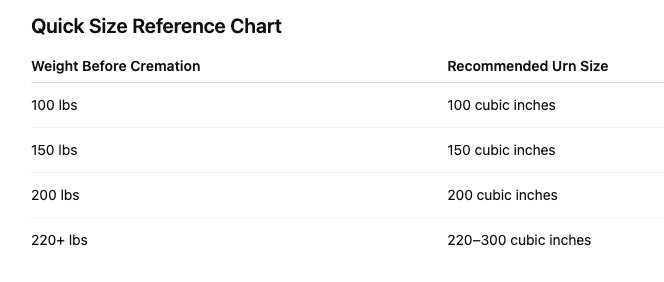What Size Urn Do I Need? A Simple Guide to Choosing the Right Urn Capacity
Choosing an urn after the loss of a loved one can feel overwhelming, especially when it comes to figuring out what size you need. Whether you're planning ahead or making arrangements after a passing, understanding urn sizes ensures you choose one that fits your needs with dignity and care.
In this guide, we’ll explain urn sizes, how to calculate the right capacity, and what to consider for adult urns, companion urns, pet urns, and keepsake urns.
How Are Urn Sizes Measured?
Urns are typically measured by cubic inches. One cubic inch equals the space needed to hold one pound of body weight before cremation.
General Rule:
For every 1 lb of body weight, you need 1 cubic inch of urn capacity.
So, a person who weighed 160 lbs would require an urn that holds at least 160 cubic inches.
Common Urn Size Categories
Here’s a quick breakdown of common urn sizes and what they’re used for:
🟦 Standard Adult Urns
Capacity: 180–220 cubic inches
Fits: One adult, up to approx. 220 lbs
Most commonly purchased urn size
🟨 Companion Urns
Capacity: 350–440 cubic inches
Fits: Two adults
Used for couples or loved ones who wish to be kept together
🟧 Keepsake Urns
Capacity: 1–25 cubic inches
Fits: A small portion of ashes
Perfect for sharing among family members or keeping a symbolic amount
🟫 Pet Urns
Capacity varies by pet size:
Small pets (rabbits, cats, small dogs): 20–50 cubic inches
Medium to large dogs: 60–120+ cubic inches
How to Choose the Right Urn Size
Ask yourself the following questions:
Am I keeping all of the ashes in one urn, or dividing them?
If dividing ashes among family, smaller keepsake urns or jewelry may be suitable.
Do I need space for mementos inside the urn?
Some people choose to place notes, jewelry, or other items in the urn, which may require a larger size.
Am I planning to bury or display the urn?
Burial urns might follow cemetery regulations; double-check size limits.
Is the urn for a person or a pet?
Pet urns vary widely and can often be customized based on your companion’s weight.
Still Unsure? Go Slightly Larger.
When in doubt, it’s safer to choose an urn that’s slightly larger than needed. A little extra space doesn’t affect the appearance or function of the urn—and it gives peace of mind knowing it will comfortably hold all remains.
Final Thoughts
Choosing an urn is a deeply personal decision, and size is one of the most practical steps in honoring a life well lived. Whether you're selecting a single adult urn, a keepsake for sharing, or a companion urn for two, knowing the right size helps you make a choice with confidence.
If you have questions or want help selecting the perfect urn, don’t hesitate to contact us. Our team is here to support you with compassion, transparency, and care.

